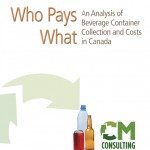Ten years ago, CM Consulting published the first version of Who Pays What, which documented the collective efforts in beverage container recycling and reuse in Canada for the first time. Since then, much has changed.
Over the last decade,Canada has become a global leader in beverage container collection and recycling. Together, Canadian provinces collect approximately 73%–75% of their aluminum cans, 80%–83% of non-refillable glass, and 58%–62% of PET plastic beverage bottles.
Click here for: WPW2012-final report
In total, including all the other container types, such as other plastic bottles, juice boxes, gable top containers, pouches, and bi-metal cans, Canadian provinces collected approximately 67% of all the non-refillable beverage containers sold in 2010. Refillable beer bottles continue to be collected at a rate of 98%, which brings the total collection rate for all beverage containers up to 72%. This rate is about twice that of the United States.
We have evolved
Our deposit-return programs have evolved by gaining efficiencies from on-site and on-truck compaction, accounting system streamlining, anti-fraud measures, reduced sorting, and greater levels of automation, all of which support cost reductions. In total, deposit-bearing containers were collected at a rate of 84% in 2010.
Our residential curbside programs are also expanding to accept a wider variety of containers and to offer recycling in more public spaces. Recycling efforts that focus on away-from-home container discards are being launched inManitoba,Quebec, andOntario. In total, non-deposit bearing containers were collected at a rate of approximately 50%–54% nationally in 2010.
Good for our economy
Canada also enjoys the economic benefits derived from our success in beverage container collection and recycling. In 2010 alone, approximately $143 million worth of revenue was generated from the sale of nearly 1.4 million tonnes of empty beverage containers sold to recyclers inCanadaor abroad.
Canadian jobs are also directly linked to our success in collection and recycling. For each tonne of container material collected, processed, and recycled, labour is required. If the containers are clean, most will remain inCanadato be used by Canadian secondary processors and manufacturers. The benefits for these industries and Canadians include reduced energy required in manufacturing processes, lower emissions, and consistent access to Canadian-sourced raw material.
The next step
As programs move forward to further increase collection, special attention should be placed on ensuring that the quality of material collected is not compromised to the point where it is no longer valuable domestically. Indeed, recycling must be organized to make sense both environmentally and economically.
Quality standards in sorting and processing should be set high enough by program operators and regulators to maintain a competitive secondary commodity marketplace for the supply of containers; to reduce the risk associated with commodity trading; and to provide an opportunity for Canadian and local manufacturers to increase their use of recycled-content plastic, glass, and aluminum.
CM Consulting looks forward to the next decade of recycling inCanada. We will continue to provide a clear and concise picture of the different models— their effectiveness and costs. I trust you will find this report useful. Please do not hesitate to contact me if you require other data or further analysis.
Respectfully yours,
Clarissa Morawski
Principal


